Skip ahead
- What is the “structure” of a website?
- The Types of Structures Which Can Be Used On Your Website
- How To Choose Website Structure For Your Own Site?
- Why is Proper Website Structure so Important?
- How Proper Site Structure Influences Behavioral Factors
- Key Components of Professional Website Structure
- Good Website Structure Ensures Sitelinks
- Keyword Distribution in Accordance with Site Structure
- Create Navigation Path and Improve Your Website Structure
- 9 Basic Steps to Create Good Site Structure
- Website Structural Errors to be Avoided at all Costs
From our previous article in this DIY SEO series, we taught you the basics of how to properly create a semantic core for your company website with professional seo services. If you followed the steps from the previous article (How to do SEO for your own website part1: The semantic core), you should have a solid foundation for your website organization and a firm understanding of what your customers are looking for. Hey, you might even be an expert by now! Today, let’s learn more about the architecture of the website. This stage is just as important as the first. In fact, all the results that you are to receive beyond this point hinge upon you completing this stage correctly. Making a mistake with website structure could cost a lot of extra time and money. In other words, this is definitely a technique worth mastering.

What is the “structure” of a website?
The structure of a website is just as it may sound. It is the interrelation of the various pages of the website with the preservation of a certain sense of website hierarchy. There are many different structure types, but the most SEO effective options are those that retain a hierarchical view to them. We at Direct Line Development, a top digital marketing agency with offices in Philadelphia, Denver, and Austin that specializes in SEO prefer to think of it as an outline when writing a paper or drafting a presentation. The site structure begins with a broad representation of the business and all of its various features also called a website architecture. This is typically represented by the home page. From here we specify further with various subpages such as “about us,” “services,” and the like. On these subpages information is now even more condensed to things such as the types of services offered and those pages may even have subpages of theirs. The point is to take the user from general to specific in a logical and convenient manner using SEO site architecture. The better the structure of a site, the easier it is to find relevant information.
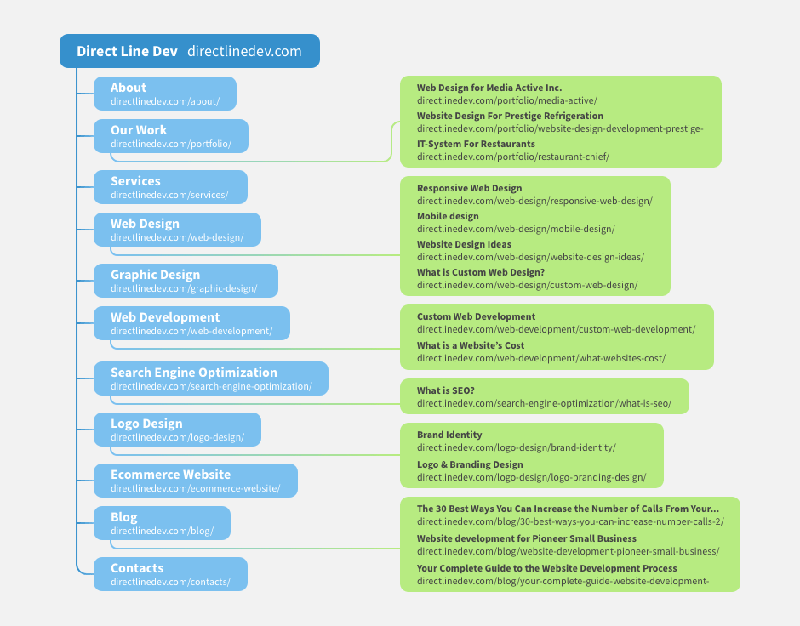
The Types of Structures Which Can Be Used On Your Website
There are 4 main website structure types which can be used during webpage creation and optimization. Each of them has its own distinctive features and advantages for the convenience of an intersociety page with a search engine or the user.
- Hierarchical - or tree structure. It is the most popular architecture type for building a site. Its peculiarity lies in the formation of the set of pages of the site in such a way that from the large pages of categories depart smaller individual pages. The most usual example of such a kind of website design architecture is e-commercial websites. So if you have a commercial site and wonder “how to find the structure of a website which will suit my aims”, choose the hierarchical structure. It will provide users with as much information about products and services as they need to make a purchase.
- Sequential - or linear site structure. The peculiarity of this structure is to build a continuous chain of pages without branches. Such an organization is suitable for small sites or just developing businesses, which allows not to multiply unnecessary pages and keep users' attention on one topic. However, there is a nuance - when choosing such a structure, you should pay attention to the chronological presentation of information - such a structure will be useful in guiding the visitor from the idea of buying a product - to its payment online. If it's done right, the client will have little choice where to go from this path.
- Database - this is an increasingly popular SEO structure that implies a bottom-up approach. This structure allows for internal site search to be implemented, making it easier for users to find the information they need. The main advantage of this website structure type is the possibility of personalization depending on your assumptions, as well as the ability to constantly add new pages to the existing structure without making global changes. However, there is a significant disadvantage to choosing this particular type of structure - you will need an experienced professional who can set up your site properly to create it.
- Matrix - the oldest and most complex website structure, which will not suit every site. Yes, it does not have a rigid hierarchical and chronological structure. It will suit those sites that have a narrow focus - for example, a training database for company systems. How to structure this website? For its creation it is not necessary to form hard links between pages, enough light hints to the existing relationship.
How To Choose Website Structure For Your Own Site?
When shaping your structure, you can choose the one you like the most, but nevertheless, there are certain patterns that will allow you to achieve the best result when choosing the structure that will help site visitors better interact with your pages.
For example, for information sites or sites with distinct categories, a hierarchical or database SEO structure is a better choice.
For sites that have pages flowing from one another, a sequential structure is better.
If your site contains pages with a lot of content or links, which can be connected with each other, then you suit the matrix site structure.
Why is Proper Website Structure so Important?
As we say in all of our articles, search engine optimization takes into account a multitude of different factors in the determination of a website’s particular rank in search engine result listings. Every website, whether purposefully or accidentally, has a structure. A website structure can be strict and balanced, or it can be a disorderly cluster of pages. By deliberately and meticulously working on your site structure from the beginning, you can ensure that you meet all of the SEO requirements on this end, and get the most out of search engines. Determining and developing the proper structure is one of the most important stages of search engine optimization. We should also note that not only is it important for SEO, but also for user experience. It is important to understand the value of SEO and website usability. The better the site structure of your website, the easier it will be to navigate. Visitors should easily - almost naturally - be able to stumble upon the information they are searching for. It should be organic. Plus, if it is easy for visitors, it is easy for Google.
Search engines are getting smarter and smarter in relation to the SEO structures. In the past, good SEO was getting visitors to a relevant homepage. Now, search engines are linking users to not only the proper structure but the proper internal pages within those websites. For example, if someone Googles Brand Identity in Philadelphia, Denver, or Austin, they would be directed not to the main page of directlinedev.com, but rather, to the Brand Identity section of the website. By taking a hands-on approach to website structure, we can teach Google how to direct our potential customers to our website and elevate our site's placement, all of which are important terms of a professional appearance. We will stress this whenever the opportunity presents itself: people do not want to work to find the information they desire. If your competitors are showing up higher in search result submissions or they are presenting relevant information to customers in a faster and more convenient manner than your own website does, you lose. Being only a search and a click away from the information your customers are searching for is huge in terms of successful SEO structure. To be the best means to be at the top. If users go online and do not see you there, you may want to consider hiring a consultant from a professional internet marketing company to create a perfect SEO structure.
What Makes Site Structure Attractive For Users And...
How to plan a website structure? To make it attractive to customers and sell them your products and services. To do this, it's worth figuring out what it is to optimize the site structure for the needs of live users, rather than soulless algorithms.
There are three main points, which should be reflected in your structure so the user would be comfortable to be on your site.
- Website Architecture Is Important for UX
If the user is pleasant and can easily find information due to your website structure (bright design does not cut the eye, the information is presented consistently, pop up windows are not annoying), then the probability that the visitor will become a customer increases many times over. Optimize your site structure so that the visitor wants to stay on your site.
- Easier to Navigate
Simplified and clear site structure navigation will help users find what they need more easily. Here it's worth clarifying that simplified navigation that doesn't bother the customer and lets them know right away where to find what they need is one way to speed up the movement of visitors through the sales funnel.
- Groups Content and Makes Pages Easy to Reach in Few Clicks
What could be more tedious than a long search for the right information on a site. Categorize your site's content, label the categories clearly, and incorporate them into the site structure.
…For Search Engines?
What is a website structure for search engines? The right structure will increase the importance and reliability of your site according to SERP algorithms. How will Google deal with poorly structured sites? Most likely such sites will not be promoted.
So, let’s see why the structure of the site takes an important place during SEO promotion.
- Topically Grouped Content
By grouping content by topic in the website structure, you show search engines that you understand what you're talking about. In the eyes of search algorithms, you look like an expert in a certain field if you are grammatically forming categories and groups to create a structure. This helps Google understand what your site is about and find the keywords you can rank for.
- Highlight Your Most Important Content
Proper website structure definition helps to highlight main information and pages of your site. This approach gives search engines the opportunity to recognize the main information and essence of the site, and to select the best keywords to rank for.
- Easier to Crawl and Find New Pages Faster
How will search engines deal with a poor site structure? If Google can't crawl all the pages on your site, it can't index them. This means that some of your pages and content will not be found in the SERPs and users will not be attracted to these pages. This problem can be avoided by making a correct and complete structure of the site.
- Your Website Architecture Passes Link Authority
One of the main factors on which your site can rank is backlinks. However, do not cram everything in the form of links into your content and website organization. The only strategy that will work is to distribute links grammatically throughout the site. To do this, use the site structure. It is important that different pages attract different links. Proper site structure will help you do this effectively.
- Helps to Prevent Keyword Cannibalization
Here we're talking about a situation where, due to a lack of structure working out, your two pages on one site begin to compete with each other. This can happen if each page is not defined for its place in the website structure.
How Proper Site Structure Influences Behavioral Factors
If you strip a site architecture definition down completely, that is, take away all of the decorative fonts, colors, images, strategic spacings, graphics, etc., it turns out that a truly good website structure stems from the manner in which it is structured. It is natural for us humans to desire balance. It is what our minds instinctively seek. Therefore, the best web design and development caters to this fundamental human need. To have a properly functioning structure, you must place all the necessary elements of the site in a manner that flows logically for the people browsing. It should be an instinctive, intuitive process. And, as you are by now well aware, the more attractive a site structure is to users, the more attractive it is to search engines like Google. That is why it is never a bad idea to get the proper website designs from the best.
The algorithm Google uses to rank your site takes into account all of these factors. If your site has a poor clickthrough rate and low visit times, this will negatively impact your site’s position in search result rankings. Similarly, if users find a site that they like, that is, a site with a well-crafted website structure, they will spend more time on it, vastly decreasing its chances for percentile decreases in rank. A verified structure can reduce the number of overall failures that the site produces and can improve the visit time, which leads to an increase in your site’s rank in Google, and thus better overall SEO structure results.
Key Components of Professional Website Structure
How to structure a website in the most attractive way both for humans and algorithms? Taking all this into account, it is best for both SEO and user experience to create individual landing pages for each of your products and services and include them into your structure. Building on this, we also recommend that you create separate sections for categories such as “About Us,” “Contact Information,” and “Feedback.” This, however, is already the market standard, so it shouldn’t seem unfamiliar to you. We should also mention that it is incredibly advantageous to include a blog section in your website structure, but we will go into more detail on this topic later on in this SEO series.
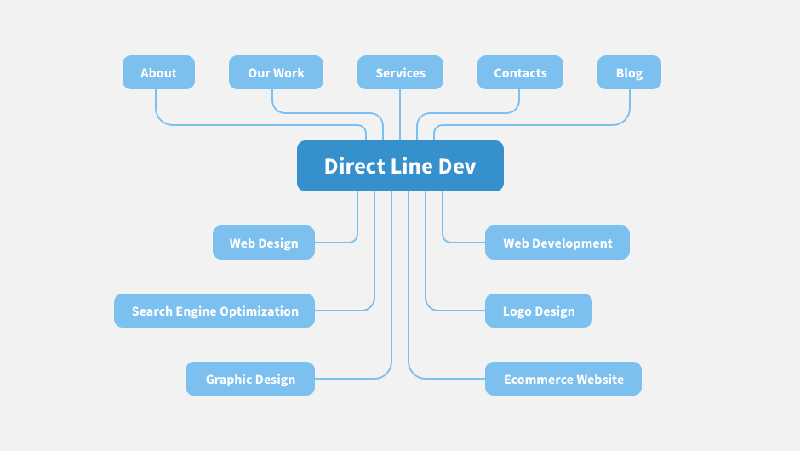
You should attempt to individualize as many aspects of your products or services as possible and to create the necessary pages to add them into the structure. Continuing from our Brand Identity example, you should determine whether or not your Brand Identity services have any further specializations to precise a future site structure. For instance, if you offer Brand Identity services for law firms and accountants, then you should create a Brand Identity page for law firms and another Brand Identity page for accountants. The goal is to funnel your users to the most specific pages and website architecture diagrams you can. We should also mention that you are not limited to what is “typical” in website layout and structure. If your business is unique and you believe it should have a section that is industry-specific, it is definitely worth talking with a developer or internet marketing consultant who will give you a piece of advice on how to create a website architecture. In most cases, you will be able to include whatever type of category on your website that you want so long as its design and structure still follow a logical pathway from general to specific. You can also do some research on your own but understanding what makes a website structure truly effective is nonetheless important. Search your competition online and note which submission typically brings them to the top of Google's listings. Placement is very important.
Good Website Structure Ensures Sitelinks
What is site architecture without a sitelink? Sitelinks are internal links to the site in the SERP. In other words, in addition to the main page of your company website, you will see several links to its individual sections.
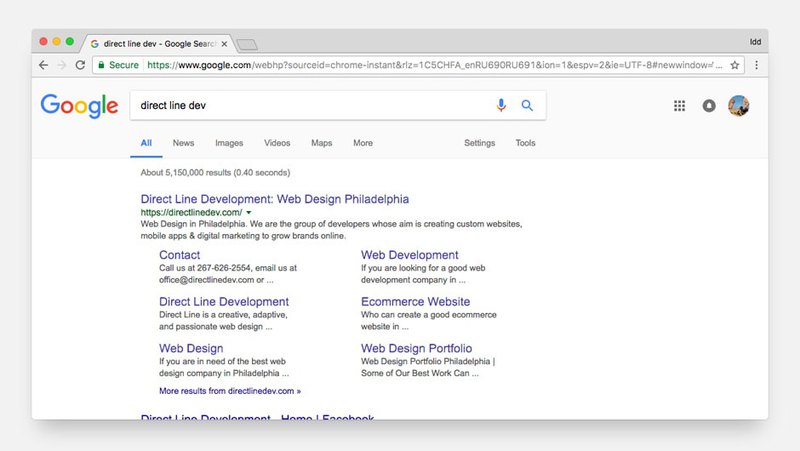
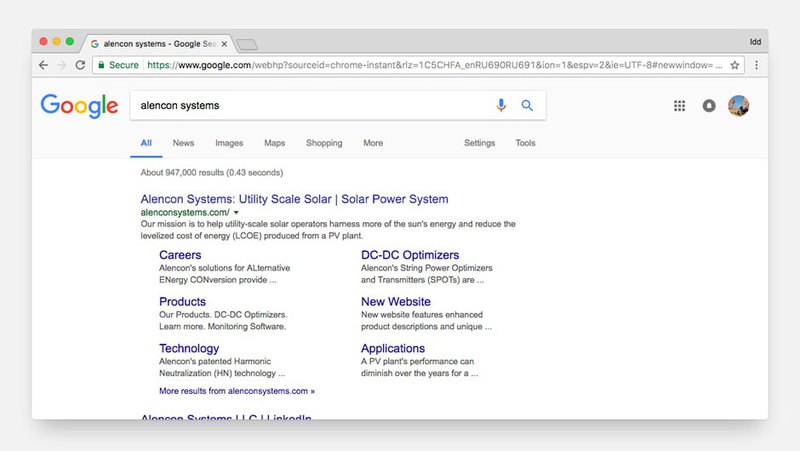
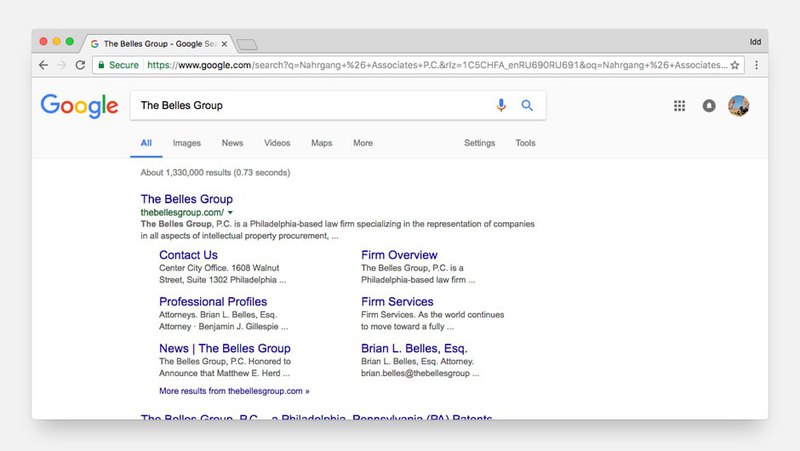
Sitelinks offer huge advantages to search engine optimization. They improve the ease with which one can navigate your SEO structure, show users the most relevant information according to their search, and they boost both the reputation of your brand and customers’ confidence in your business. Further, they help you dominate the search results page, increase the click-through rate of your site, and reduce the conversion funnel through the properly used website hierarchy. This all sounds amazing, but how do you get site links? You cannot simply go to the “tools” section of Google Webmaster and check off a couple of boxes. Instead, it is only through a proper structure that Google’s algorithms will automatically award the website with additional links on each page. Sitelinks are the result of having a good and well-thought-out site structure. This is just one of a few SEO tips that will help grow your campaign. If you see that your structure is clearly lacking, you may never find yourself receiving site links from Google. By ignoring this, you are blatantly accepting less targeted traffic, low click rates, and decreased conversion.
Easy and clear navigation and clear internal link SEO structure helps PageRank navigate your site. PageRank (PR) is the authority of a web page, which is formed by the reliability of its links (both internal and external). It is Google's oldest algorithm and was the first of the methods of ranking a site structure by search engines.
By creating internal linking on the pages of your site you show this algorithm the path of your site. In this case, the pages with the most links will rank better than others. However, do not cheat here and try to stuff in your content absolutely unnecessary links, which will stand out against the text.
Keyword Distribution in Accordance with Site Structure
After we have established the basis of your site structure, we will next need to distribute the keywords we compiled during the creation of the semantic core (see the previous article for more details on this). The most effective SEO structure promotion strategy is to promote one keyword per website page. The highest-frequency (most competitive) keyword or phrase should be promoted on the main page of the website. Other HF and MF words and phrases should be distributed throughout the rest of the service pages.
As you may have noticed, we have only distributed a small portion of our words and phrases throughout our site structure. This is to avoid an oversaturation of keywords on our website, a mistake that would negatively affect our SEO campaign. In order to add the rest of our words and phrases to the structure of the site, we will need to create additional pages to which these new words would correspond. This is not to say that it is impossible to promote more than one word per page, but it will be much less effective.
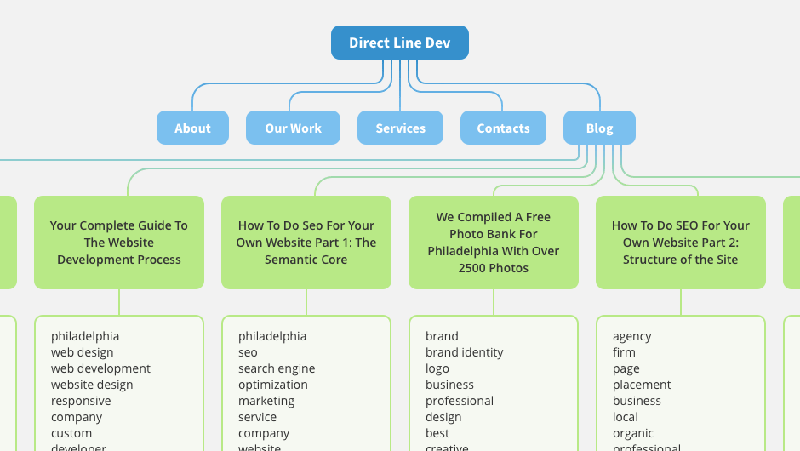
After this, we can continue to dive deeper and deeper into the specification of new pages for new keywords. You can forever continue to add new pages with relevant information that corresponds to different search requests and boost your SEO results.
Create Navigation Path and Improve Your Website Structure
Additionally to the clear site structure you need to optimize a user-friendly navigation. Each well-structured website has three essential elements: menu, breadcrumbs and sitemap.
- Menu
What's the first thing that comes to mind when you think of site navigation? The menu, of course. This is the most common option for showing how to structure website and to create navigation.
Organize your pages into groups and form groups into menus so users can easily find what they're looking for. If you have a large site structure which implies the presence of many categories, you can make branched menus or even create a second or additional menu on the top of the site.
- Breadcrumbs
Breadcrumbs is a visualization of the path a user has taken from the main page of the site to where they are now. It's a brief display of the website hierarchy that any user can see. As a rule, breadcrumbs are located at the top of the page. The second purpose of the breadcrumbs, as a display of the website organization - a short path to the category page, which includes the page on which the user is. Elements of breadcrumbs are active links to other pages of the same site.
Breadcrumbs help users determine where they are on your site. They improve both the user experience as well as the SEO of your site.
For small sites with a small structure breadcrumbs are not a necessity. But with the development of website structure and the emergence of new pages, you should think about creating breadcrumbs. If your site has more than one page of the third level, you need to put breadcrumbs and the site structure.
- Sitemap
When creating a good structure, pay attention to setting up the site for search robots. A sitemap is a list of all the pages that make up the website structure. If it is set up correctly, search engine crawlers will be able to track your pages and index them. Search engines can also use the sitemap as a reference when determining canonical URLs. Sitemap.xml can work as a list of all URLs and display their hierarchy or as a list of all user-accessible pages.
9 Basic Steps to Create Good Site Structure
- Plan The Hierarchical Structure Of The Site Before You Proceed To The Development Stage
- Distribute the Keywords By Structure
- Categorize your keywords to create a content hierarchy
- Identify main keywords for your top-level pages
- Expand your top-level pages into necessary deeper levels
- Combine The URL Structure With Your Navigation Hierarchy
- Stick To The Depth Of More Than Two Sections
- Create Short Names Of Sections
- Set Up Internal Linking
Plan The Hierarchical Structure Of The Site Before You Proceed To The Development Stage
If you have just started to develop your website structure, but you can already say for sure that it will be extensive, you can look at the options for filling it with potential competitors. Analyze the most successful and popular competitors of their website and website structure to understand how to plan a website structure that will be able to reach the top of search services. Using a structure similar to your competitors also creates a sense of familiarity for your visitors.
Run the selected structure through an analytics program to find out what percentage of organic traffic comes from each element of the site structure. Determine those elements that you like and fit more than others and use them to create your own structure. If your goal is to create a commercial site - consider the options structures used by the giants of online shopping such as Amazon or Ebay.
When dealing with the website hierarchy you should follow a certain rule, which will not allow you to confuse yourself in your structure.The hierarchy must be logical, and the optimal number is 5 per main section.
Distribute the Keywords By Structure
Before you start, you should analyze keywords to determine which ones will work for you. You should also pay attention to their performance and sort out those that won't help you promote your site structure.
Use keyword analysis to form your site structure. You can use keywords with search volume and organic traffic potential for the main elements of the structure.
Categorize your keywords to create a content hierarchy
In this way you will be able to identify what unites some keywords and separate them into a separate page that will complete the structure. This format of keyword sampling is an integral method of building a website structure for all of the world's major e-commerce companies.
By selecting keywords to highlight specific categories of the site structure you get an excellent opportunity to form a clear hierarchy of the site - to highlight categories, subcategories, subpages and filters.
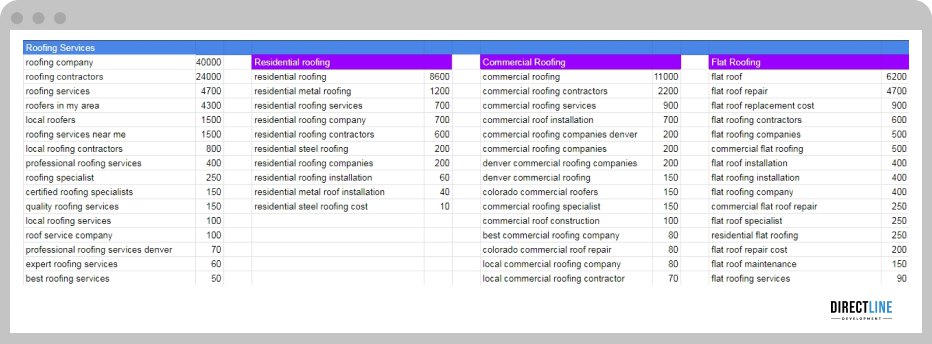
Identify main keywords for your top-level pages
Determine the main pages of your site structure and select the most appropriate keywords for them. Conduct a competitor analysis and an analysis of the most relevant keywords for your queries.
For example, we searched for landscape materials keywords for our client and separated categories by following the research results:
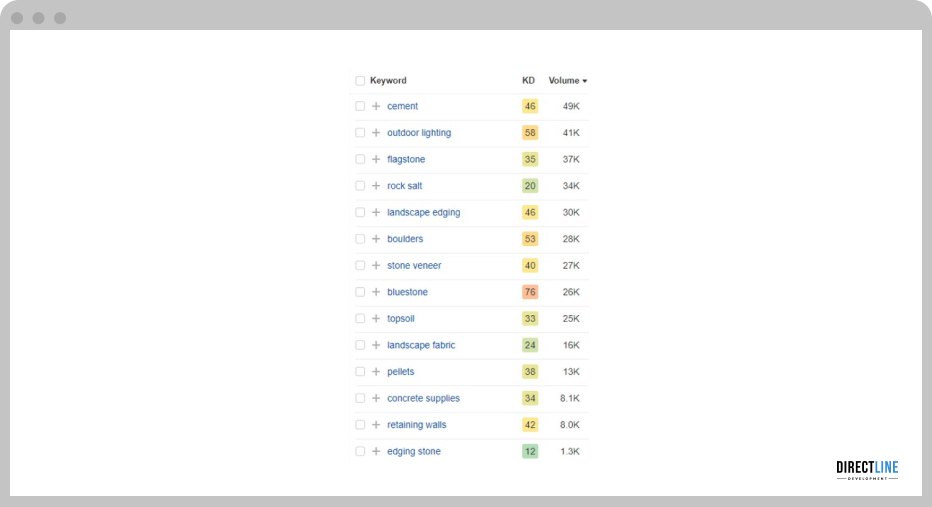
Expand your top-level pages into necessary deeper levels
To work out the site structure, you should clearly designate which of the pages will belong to the upper level, and which to the lower level. For example, pages containing specific and highly specialized information about an area or subject should be designated as subcategory or lower-level pages. Typically, such pages do not need subsequent deeper level pages.
At a higher level in the website architecture can be allocated category pages, which include blog pages, pages of categories of products and services.
The highest level in the hierarchy of the website will be the hub page - a page that will contain general information about the topic with links to numerous subcategory pages.
The decision to expand the site structure should be based on your knowledge of the industry, the perspective of the site and keyword research. The keywords that you have analyzed before will help form the structure of the website more accurately and give ideas for further expansion of the site.
Combine The URL Structure With Your Navigation Hierarchy
The URL structure should follow your navigation website hierarchy. Display all the way from the home page through all the categories to the page you want in the URL. For example, you can easily bring up our site’s section on Responsive Web Design through this link https://directlinedev.com/web-design/responsive-web-design/
Stick To The Depth Of More Than Two Sections
Remember that it is highly undesirable to have a nesting depth of more than two sections, with the maximum being three. So users will be easier to find the information they need and not get lost in the site structure.
Create Short Names Of Sections
The names of each main section and subsections should be short and understandable so that they fit aesthetically on the page and are quickly understood by users.
Set Up Internal Linking
You should immediately register internal linking between sections so that traffic is directed smoothly and logically.
Website Structural Errors to be Avoided at all Costs
Firstly, you should avoid nesting more than two times since Google will subsequently rank each page lower and lower. Instead, you should have the nested page in your website structure ready on-demand with the root from the older page already embedded. For example, we have a Web Design page with its own Web Design for Local Business sub-page. Implementing a different website structure definition for the same types of pages is also a big mistake. For instance, if you sell fashion accessories such as glasses, and you divide the types of glasses between men and women, these separate sections should still be organized the same way during work on website organization . Always be consistent. Finally, consider this final rule of website structuring: NEVER make duplicate pages. Duplicating pages will adversely affect your results in Google because its algorithms flag it as a copycat site and reduce its overall rank. Any marketing agency telling you otherwise is not to be trusted. Every page on your website should be 100% unique or you can say goodbye to SEO forever!
To Summarize: Site Structure Is Important For SEO
Remember that site structure must flow logically in an organized fashion. Think of it as a walk through the grocery store. You find related items placed all throughout the store in a manner that seems to guide you through it. This is exactly what your website structure should do. Users should effortlessly navigate through your site until they reach the information they desire. Once you have read this article and part one of the series, you will be ready to understand further topics on website promotion through organic search engine optimization strategies. There are still more interesting tips and tricks to come! If you have any questions about how to plan a website structure, feel free to contact our office or leave them in the comments section below. If you are local to the Philadelphia, Denver, or Austin area and would prefer a face-to-face meeting, get in touch with us today with one of our specialists and we will help you to create a structure for your website. Happy promoting!




Comments
Structure is paramount when building any website, following this logical approach goes a long way with Google and SEO. Google likes to see a highly organized website guiding the visitor down the correct path. Great read on the importance of this and how it plays a part in SEO!
This is a very useful article and itis extremely important that it describes every step in details, so anyone can follow these steps to do SEO for their website themselves. SEO is a complex technique and it is not easy, but the results which you might reach worth the time and effort.
Great primer on SEO - There is a lot to great SEO and I can see the value in hiring someone to do it for you.
This extremely helpful in understanding what's important when we talk about SEO strategies. There's a number of companies out there that claim that they are doing SEO for their clients, but do not take the time to do all these things described in this article.
Website structure is an essential part of SEO. Creating pillar pages that expand your site accordingly will only grow your SEO campaign that much more. Keep this in mind when choosing which company you want to work with.